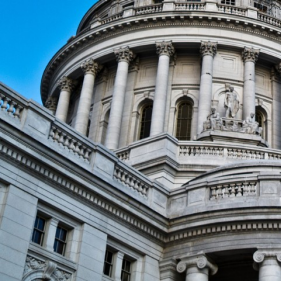By Douglas J. Elliott
This article was first published on July 24, 2020.
It’s time to start debating the lessons for financial regulation from the Coronavirus Recession. Sure, it’s early and we will learn more as the crisis unfolds, but these debates will take substantial time, so it is good to get started. Further, a clear-eyed review will help shape the continuing policy response.
Several of these lessons were actually clear before the crisis, but were not accepted by the regulatory community, either because they did not believe the arguments or because the necessary actions ran up against other policy goals. For example, my paper on "Banks and the Next Recession" warned about many of the problems described below and I wrote in other papers about the liquidity issues. Nor, of course, was I alone in my concerns, especially on the liquidity issues and on the ability to use buffers.
At the same time, it’s not all about concerns and weaknesses. The biggest lesson of this crisis may simply be that the regulatory reforms of the last decade largely worked. It’s always been my view that they would, taken as a whole, but it’s very good news that they have.
Please note that this paper focuses on lessons learned from our experiences. Any redesign of the financial system will also need to focus on future issues, such as climate change and associated policy implications and the many issues that arise around the increased role of Big Data and machine learning.
Finally, all of these topics are complex and require much more discussion. This paper lays out my views based on my own observations and many discussions with officials and market participants. In the interests of time, I do not provide proof of my assertions here. Below is the web version, for the "Lessons In Financial Regulation" PDF version, please click here.
The biggest lesson of this crisis may simply be that the regulatory reforms of the last decade largely worked
THE GOOD NEWS
1. Overall, regulatory responses to the Global Financial Crisis increased financial stability greatly. (CLICK HERE)
Financial systems across the globe were much better placed to weather the Coronavirus Recession because of increases in capital requirements, the imposition of liquidity requirements, stronger stress testing, overhauls of risk management, and the myriad of other changes imposed by regulators in the last decade. Credit should be given as well to private sector responses for the lessons learned from 2008-09.
2. Aggregate capital requirements were broadly right in most jurisdictions, although there were problems in the composition of the “capital stack.” (CLICK HERE)
Many in the industry felt that regulators overshot considerably to the upside in their demands for capital, creating needless costs and burdens for borrowers. This argument has been largely disproven, now that we’ve suffered an even worse shock than the Global Financial Crisis just a little over a decade after that first shock. There are a lot of risks in the world and capital is a crucial protection against those dangers.
At the same time, academics and politicians calling for substantially higher levels of capital should pause to reconsider now that the banking system seems to be handling the worst recession since the Great Depression. Perhaps we will feel differently about this if the Coronavirus Recession creates much larger financial stability impacts than appears likely. To be clear, we are still in the early stages and I fully expect there will be a lot more damage to banks before this is over. Right now, though, total capital levels appear more than sufficient for the global financial system to weather the full storm, even if some individual institutions suffer badly and even fail.
That all said, I want to acknowledge that capital requirements are hardly an exact science and there are very respectable arguments for raising or lowering the total global requirements by, say, a fifth. Further, of course, there are differences between jurisdictions in the risks they face and in the quality and quantity of their capital.
3. Countercyclical capital buffers proved very useful. (CLICK HERE)
Countercyclical capital buffers performed almost perfectly as the Coronavirus Recession hit. Authorities who had set them at levels greater than zero were able to take them down almost immediately and this did free up capital to be redeployed by banks, just as theory said it should. It may be that this crisis represented nearly the perfect conditions — a big macroeconomic shock that was not caused by the financial sector and which was recognized quickly. Nonetheless, the experience showed that this buffer can be very valuable, as I have always argued.
THE BAD NEWS
1. Capital conservation buffers (CCBs) proved problematic. (CLICK HERE)
Again, as predicted by many, including me, the CCB is considerably harder to use effectively than the countercyclical capital buffer is. At the core, this is because regulators built a mixed message into its use. On the one hand, they have made very clear from the beginning that this buffer was intended to be used under the right circumstances. On the other, they deliberately put in penalties for their use. I think this mixed message reflected the desire of officials to have the CCB work for both idiosyncratic problems at one or a small set of banks (meriting a penalty) and for a larger systemic situation (where penalties are counterproductive). The result of the mixed message is that (a) bank managements, investors, and equity analysts perceive a major stigma effect if a bank uses the buffer and (b) there really are penalties, further detracting from the desire of banks to use the buffer. It would be better to switch some or all of the CCB to the countercyclical capital buffer, leaving only as much as is desired for idiosyncratic situations.
2. Market liquidity does matter and it was damaged by the way prudential regulation of banks was structured. (CLICK HERE)
It was clear for years, even to substantial numbers of bank regulators, that the prudential regulations on banks were constructed in ways that substantially discouraged market making activities. However, there was a question in the minds of many regulators as to whether bank market making was important or necessary for reasonable market liquidity. They either felt market liquidity was overrated as an issue or that non-banks could easily replace the role of banks. In practice, it was very hard to demonstrate ill effects from reduced bank market
making in a period when market liquidity was generally high, in part due to very accommodative monetary policies. The crisis was an extreme demonstration of both why liquidity matters and the difficulties of non-banks in providing sufficient liquidity under stress conditions.
All that said, there remains the tough issue of how best to ease constraints on market making while still preserving the prudential benefits of the various measures creating those constraints. Hopefully, there will be some restructuring of the regulatory requirements, but it is possible that officials will simply decide to accept the periodic need for massive central bank infusions of liquidity as the way to solve the problems when they arise. This would be a pity, as there are serious drawbacks to a system that requires such a large degree of central bank intervention into troubled market segments.
3. Officials never did figure out how to integrate non-banks and markets into the overall framework. (CLICK HERE)
It is very well recognized that regulators spent the last decade toughening the regulation of banks while doing far less with other parts of the financial system. This was due to at least four factors:
- Banks are central to the financial system and were therefore viewed as the first priority
- Non-banks and markets were not deemed to need the same degree of prudential regulation
- There was a strong public demand for banks to be more highly regulated, particularly “Wall Street” banks
- The main prudential regulators have little or no authority over non-banks and markets
4. Government credit guarantees can interact badly with prudential requirements. (CLICK HERE)
There is a push and pull between the desire of governments to use banks to push credit into the economy, with government guarantees covering the great bulk of the risk, and the desire to apply normal prudential requirements. For example, many banks feared that with the Main Street Lending Program in the US, they would be encouraged to make loans that were 95 percent guaranteed by the Federal Reserve and Treasury, but which would from day one be “classified” loans that trigger a number of penalties due to their higher risk. Supervisors or regulators could waive this classification issue, but this ran counter to their desire to ensure that banks keep their normal credit standards in place more generally. Whatever the merits of this particular situation, many banks in various countries are concerned about the tension between government pressure to lend freely and regulatory/supervisory pressure to lend only cautiously in this highly uncertain and troubled environment.
5. IFRS 9 and CECL did add procyclicality. (CLICK HERE)
Recent accounting changes at both the global and US levels were intended to reduce the trend for loan reserves to be too low in good times by moving reserving levels to better reflect losses over the course of a credit cycle. Many warned in advance that the actual mechanics could trigger a sharp increase in loss reserves when a recession hit, at least in the first years of implementation. This appears to be the case and officials have had to scramble to find ways to dampen this volatility, particularly in terms of how it flows through into bank capital levels.
Financial systems across the globe were much better placed to weather the Coronavirus Recession because of increases in capital requirements, the imposition of liquidity requirements, stronger stress testing, overhauls of risk management, and the myriad of other changes imposed by regulators in the last decade
FRAMEWORK ISSUES
There are two further areas that are more complicated. Formal mandates and formal and informal frameworks influence regulatory and other official sector decisions in important, but sometimes subtle, ways. I’m concerned that financial stability mandates, as they were applied in practice, and the US stress testing framework both created issues for the financial system.
1. Financial stability is about the ability to provide the necessary level of credit and other services, not just the avoidance of institutions falling over. (CLICK HERE)
Most official financial stability mandates take continued credit provision into account, but I believe that in practice the prudential requirements have focused too heavily on avoiding failures of major financial institutions. One consequence of this has been an unintentional encouragement of the trend for plain vanilla credit business to move from banks to non-bank financial institutions and to investment funds. Unfortunately, as noted, non-banks are considerably more procyclical in their behavior than banks, on average, which magnified the size of the credit gap that governments and central banks have had to fill.
Another consequence has been insufficient focus on the impact of prudential regulations on market liquidity, as discussed earlier. I am confident there have been other issues that have been created by this framing as well, even if they show up more subtly.
2. Stress tests have some problems in a crisis if they are used as the most binding capital requirements in peacetime. (CLICK HERE)
The Federal Reserve chose, for a variety of reasons, to use the CCAR stress tests as the most binding capital constraint for the largest US banks. This allowed them to move capital levels for those banks to a range with which the Fed was comfortable, which was significantly higher than the banks would have chosen or than would have been required by other constraints.
However, it creates an issue when a crisis hits, because the media and investors reasonably expect that stress tests will reflect a considerably worse situation than the current one. This leads to a delicate balancing act where the Fed needs to use a scenario for future developments that is viewed as tough enough to be credible, but which won’t produce such a big hit to capital that banks will unnecessarily pull back on lending, or fail to meet rising credit demands, in order to preserve sufficient capital. It is certainly theoretically possible to do this, since the Coronavirus Recession has already created a lot of damage and the Fed can reasonably argue that the additional pain is unlikely to be anything like the magnitude of the difference between peacetime conditions and the results of stress scenarios run in peacetime. But, observers have been trained to expect stress tests to add a great deal of stress beyond current conditions and therefore may question the test’s credibility, especially given the sheer level of uncertainty caused by the pandemic.
Financial stability is about the ability to provide the necessary level of credit and other services, not just the avoidance of institutions falling over
CONCLUSION
It is probably too early for regulators to focus on actively changing global financial regulation, but it’s not too early for the analysis and debate to begin. That debate will take time to mature and the discussion will also help us frame developments as they occur and perhaps even to preempt some problems that would otherwise occur.
Douglas Elliott is an Oliver Wyman partner focused on the intersection of Finance and public policy. He is the author of the book, Uncle Sam in Pinstripes: Evaluating US Federal Credit Programs. Prior to his current position, he was a scholar at the Brookings Institution and a Visiting Scholar at the IMF. Before that, he was the founder and principal researcher for the Center On Federal Financial Institutions. He began his career with two decades as an investment banker, primarily at JP Morgan.




.jpg.imgix.fourColumnTile.jpg)




